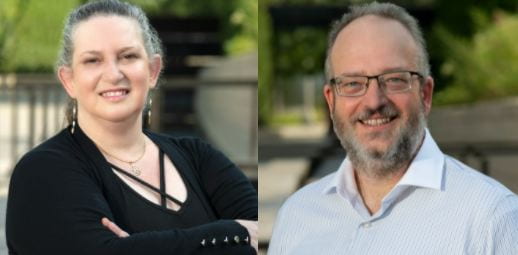
QuantCAD Cofounders Jennifer Flatté and Michael Flatté
Computer-aided design (CAD) software is a standard tool of engineering. Using CAD software, a virtual model of a device such as a drone or prosthetic limb can be created, tested, and optimized before any actual manufacturing begins.
QuantCAD fills this role for quantum technology: their software, which runs on a classical computer, can simulate the effect of quantum noise and other environmental variables on devices such as quantum sensors or quantum computers. With this information, quantum engineers can design and manufacture effective devices.
“Our software will make quantum sensing devices and characterization devices work better by being able to simulate some of the variables that designers don’t really have access to, and which the end user has no real way of computing,” said QuantCAD head of operations Jennifer Flatté.
Quantum devices are not currently available on shelves; custom-order companies can create the devices to exact specifications, but researchers don’t always have a way to find out what the best specifications for their application are. “Most of the time, the first iteration fails,” Jennifer Flatté said. “So we step into the middle and provide the ability to figure out how to make the device work where it’s designed to work, so you don’t need to play a guessing game.”
QuantCAD chief scientist and founder Michael Flatté is a physics professor at the University of Iowa. His research group had developed software to characterize the properties of certain quantum devices. He wanted to make those tools available to other research groups, including those at companies and national labs, so he founded QuantCAD in 2009 to secure the licensing rights to the software. Since then, QuantCAD has focused on making useful software specifically for quantum technology applications, and provides services using the software to calculate properties for others.
Their current product simulates quantum noise, which is analogous to signal noise in traditional electronics. However, quantum noise has effects on quantum devices that are distinct from those of typical signal noise; fragile quantum properties, like entanglement, are particularly sensitive to classical effects such as the movement of electrons.
“There are commercial software packages that allow you to simulate semiconductor electronics to figure out what kind of sensitivity you might have to classical signals,” said Michael Flatté. “We are hoping to play that role in the quantum world.”
Since QuantCAD’s software runs on classical computers, Jennifer Flatté said, “we’re part of the quantum of the now as opposed to the quantum of the future.” Their product isn’t quantum itself, but will be a crucial tool to make quantum ideas into quantum products, and improve quantum engineering design.
“We are really using what we have learned from Duality in our company right away,” said QuantCAD chief technical officer Zhi Gang Yu. “It has helped us make really important decisions.”
“In the true meaning of an accelerator, we feel that we’re going from a snail’s pace to racecar speeds,” said Michael Flatté. “The resources have been tremendous. The advice and the insight have already helped us focus on targets that are going to be more effective for us near term.”
